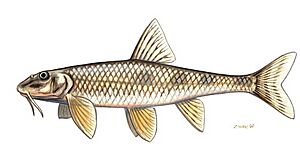Danubian longbarbel gudgeon facts for kids
Quick facts for kids Danubian longbarbel gudgeon |
|
|---|---|
 |
|
| Conservation status | |
| Scientific classification | |
| Synonyms | |
|
The Danubian longbarbel gudgeon (also called the Danube gudgeon) is a type of freshwater fish found in Europe. Its scientific name is Romanogobio uranoscopus. This fish lives in rivers across many countries, including Austria, Germany, Hungary, and Ukraine. It belongs to a family of fish called cyprinids, which includes carps and minnows.
Contents
About the Danube Gudgeon
The Danube gudgeon can grow up to 15 centimeters (about 6 inches) long. Most often, they are around 10 to 12 centimeters (4 to 5 inches).
Special Features
This fish has two long whiskers, called barbels, near its mouth. These whiskers are long enough to reach past its eyes. The fish uses these barbels to feel around in the sand and gravel. This helps it find food hidden on the riverbed.
The Danube gudgeon does not have scales on its throat. This is a good way to tell it apart from a similar fish, Kessler's gudgeon. Its back fin has seven rays that branch out. The fish is mostly silver with a few dark spots. It also has a thin blue line along its side, called the lateral line. This line helps the fish sense movements in the water.
Where the Danube Gudgeon Lives
The Danube gudgeon lives in fast-flowing rivers that feed into the main Danube River. It does not usually live in the main Danube River itself, except for its upper parts. This fish prefers areas with sandy or gravelly bottoms.
Life Cycle and Habits
Danube gudgeons lay their eggs between May and September. They choose shallow areas with rocky or gravelly bottoms. The fish swim up to the surface in open water where the current is strong. The eggs and milt (fish sperm) are released there. The fertilized eggs then sink and stick to the bottom.
Young gudgeons are active during the day. However, adult gudgeons usually live alone and are active at night. Both young and adult fish eat different kinds of invertebrates. These include earthworms, insect larvae, and small crustaceans.
Conservation Status
The IUCN Red List of Threatened Species keeps track of how many animals are left in the wild. They list the Danube gudgeon as "Least Concern". This means there are many of these fish, and they are found in many places.
However, the Danube gudgeon is sensitive to dirty water. It can also be affected by too much mud or sand in the water. This can happen when dams are built. Human activities that disturb their habitat might also harm them. Even though their numbers seem to be slowly going down, it's not happening quickly enough to be a major worry right now.


